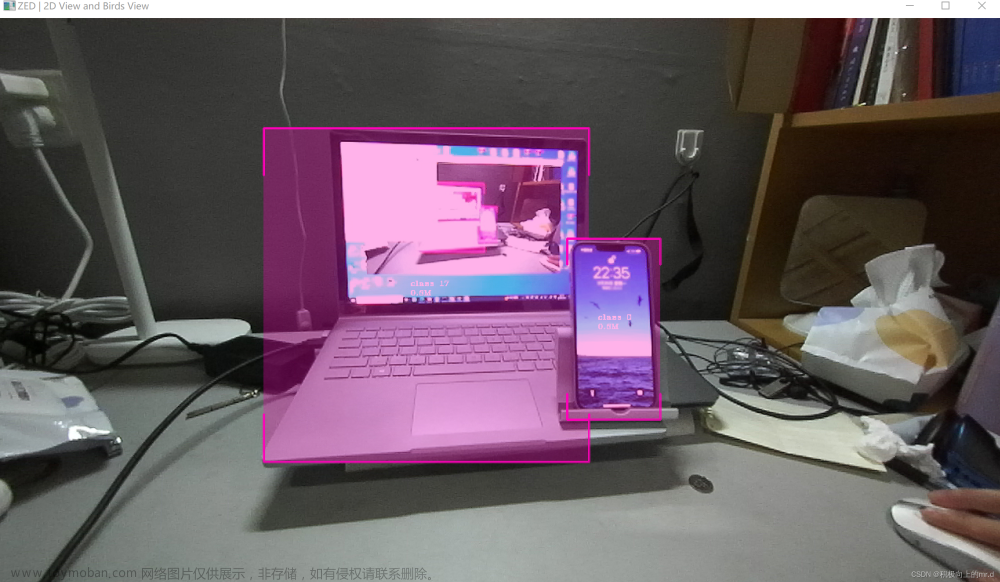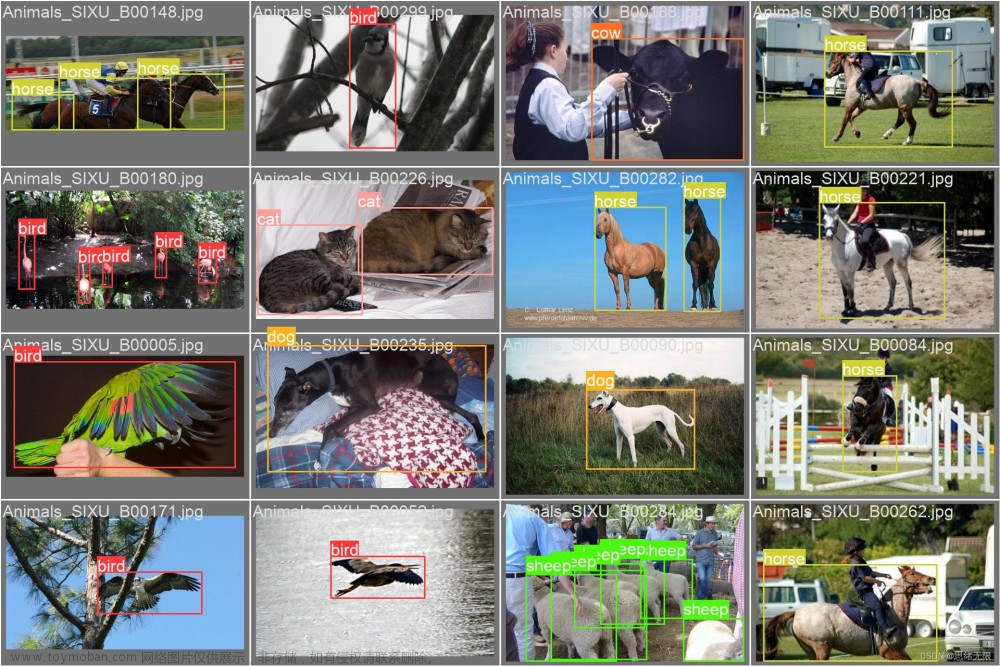1. YOLOv5+双目测距
2. zed+yolov5实现双目测距(直接调用,免标定)
3. zed+yolov4实现双目测距(直接调用,免标定)
4. 本文具体实现效果已在Bilibili发布,点击跳转
5. 如有需要,可以参考我上边的几篇文章进行对比👆👆👆
yolov7直接调用zed相机的代码也已经实现,可以运行10秒左右,会报cuda空间不足的错误,博主gpu为6G,可能是内存太小了。
1. 实验效果
经过一系列实验,结果表明yolov7结合双目实现测距效果不如yolov5,具体参数如下:
yolov5— 每帧速度:100-200ms
yolov7(不加多线程)— inference速度:400ms左右 NMS速度:1200-1500ms
yolov7(加多线程)— inference速度:400ms左右 NMS速度:200ms左右
inference:推理速度,指预处理之后的图像输入模型到模型输出结果的时间
NMS :你可以理解为后处理时间,对模型输出结果经行转换等
2. 相关配置:
电脑系统:win10 (linux及Ubuntu同样适配)
Python版本:3.6
相机型号:zed2i (普通双目也可用)
所用分辨率:2560x720 (这个可以自己调节)
3. 测距原理
测距原理详见:双目三维测距(python)
4. 实验流程
yolov7实验步骤和yolov5一样,大致流程: 双目标定→双目校正→立体匹配→结合yolov7→深度测距
找到目标识别源代码中输出物体坐标框的代码段
找到双目测距代码中计算物体深度的代码段
将步骤2与步骤1结合,计算得到目标框中物体的深度
找到目标识别网络中显示障碍物种类的代码段,将深度值添加到里面,进行显示
5.相关代码
5.1 双目相机参数stereoconfig.py
双目相机标定误差越小越好,我这里误差为0.1,尽量使误差在0.2以下
import numpy as np
# 双目相机参数
class stereoCamera(object):
def __init__(self):
self.cam_matrix_left = np.array([[1101.89299, 0, 1119.89634],
[0, 1100.75252, 636.75282],
[0, 0, 1]])
self.cam_matrix_right = np.array([[1091.11026, 0, 1117.16592],
[0, 1090.53772, 633.28256],
[0, 0, 1]])
self.distortion_l = np.array([[-0.08369, 0.05367, -0.00138, -0.0009, 0]])
self.distortion_r = np.array([[-0.09585, 0.07391, -0.00065, -0.00083, 0]])
self.R = np.array([[1.0000, -0.000603116945856524, 0.00377055351856816],
[0.000608108737333211, 1.0000, -0.00132288199083992],
[-0.00376975166958581, 0.00132516525298933, 1.0000]])
self.T = np.array([[-119.99423], [-0.22807], [0.18540]])
self.baseline = 119.99423
5.2 图像处理
以下是stereo.py里对图像进行处理的代码
这些都是网上现成的,直接套用就可以
class stereo_dd:
def __init__(self,imgl,imgr):
self.left = imgl
self.right = imgr
# 预处理
def preprocess(self, img1, img2):
# 彩色图->灰度图
if(img1.ndim == 3):#判断为三维数组
img1 = cv2.cvtColor(img1, cv2.COLOR_BGR2GRAY) # 通过OpenCV加载的图像通道顺序是BGR
if(img2.ndim == 3):
img2 = cv2.cvtColor(img2, cv2.COLOR_BGR2GRAY)
# 直方图均衡
img1 = cv2.equalizeHist(img1)
img2 = cv2.equalizeHist(img2)
return img1, img2
'''
# 消除畸变
def undistortion(self, image, camera_matrix, dist_coeff):
undistortion_image = cv2.undistort(image, camera_matrix, dist_coeff)
return undistortion_image
'''
# 消除畸变
def undistortion(self, imagleft,imagright, camera_matrix_left, camera_matrix_right, dist_coeff_left,dist_coeff_right):
undistortion_imagleft = cv2.undistort(imagleft, camera_matrix_left, dist_coeff_left )
undistortion_imagright = cv2.undistort(imagright, camera_matrix_right, dist_coeff_right)
return undistortion_imagleft, undistortion_imagright
# 畸变校正和立体校正
def rectifyImage(self, image1, image2, map1x, map1y, map2x, map2y):
rectifyed_img1 = cv2.remap(image1, map1x, map1y, cv2.INTER_AREA)
rectifyed_img2 = cv2.remap(image2, map2x, map2y, cv2.INTER_AREA)
return rectifyed_img1, rectifyed_img2
# 立体校正检验----画线
def draw_line(self, image1, image2):
# 建立输出图像
height = max(image1.shape[0], image2.shape[0])
width = image1.shape[1] + image2.shape[1]
output = np.zeros((height, width, 3), dtype=np.uint8)
output[0:image1.shape[0], 0:image1.shape[1]] = image1
output[0:image2.shape[0], image1.shape[1]:] = image2
# 绘制等间距平行线
line_interval = 50 # 直线间隔:50
for k in range(height // line_interval):
cv2.line(output, (0, line_interval * (k + 1)), (2 * width, line_interval * (k + 1)), (0, 255, 0), thickness=2, lineType=cv2.LINE_AA)
return output
# 视差计算
def stereoMatchSGBM(self, left_image, right_image, down_scale=False):
# SGBM匹配参数设置
if left_image.ndim == 2:
img_channels = 1
else:
img_channels = 3
blockSize = 3
paraml = {'minDisparity': 0,
'numDisparities': 128,
'blockSize': blockSize,
'P1': 8 * img_channels * blockSize ** 2,
'P2': 32 * img_channels * blockSize ** 2,
'disp12MaxDiff': -1,
'preFilterCap': 63,
'uniquenessRatio': 10,
'speckleWindowSize': 100,
'speckleRange': 1,
'mode': cv2.STEREO_SGBM_MODE_SGBM_3WAY
}
# 构建SGBM对象
left_matcher = cv2.StereoSGBM_create(**paraml)
paramr = paraml
paramr['minDisparity'] = -paraml['numDisparities']
right_matcher = cv2.StereoSGBM_create(**paramr)
# 计算视差图
size = (left_image.shape[1], left_image.shape[0])
if down_scale == False:
disparity_left = left_matcher.compute(left_image, right_image)
disparity_right = right_matcher.compute(right_image, left_image)
else:
left_image_down = cv2.pyrDown(left_image)
right_image_down = cv2.pyrDown(right_image)
factor = left_image.shape[1] / left_image_down.shape[1]
disparity_left_half = left_matcher.compute(left_image_down, right_image_down)
disparity_right_half = right_matcher.compute(right_image_down, left_image_down)
disparity_left = cv2.resize(disparity_left_half, size, interpolation=cv2.INTER_AREA)
disparity_right = cv2.resize(disparity_right_half, size, interpolation=cv2.INTER_AREA)
disparity_left = factor * disparity_left
disparity_right = factor * disparity_right
trueDisp_left = disparity_left.astype(np.float32) / 16.
trueDisp_right = disparity_right.astype(np.float32) / 16.
return trueDisp_left, trueDisp_right
5.3 测距代码
if save_img or view_img: # Add bbox to image
label = f'{names[int(cls)]} {conf:.2f}'
plot_one_box(xyxy, im0, label=label, color=colors[int(cls)], line_thickness=1)
x = (xyxy[0] + xyxy[2]) / 2
y = (xyxy[1] + xyxy[3]) / 2
if (x <= 1280):
t3 = time_synchronized()
p = num
height_0, width_0 = im0.shape[0:2]
iml = im0[0:int(height_0), 0:int(width_0 / 2)]
imr = im0[0:int(height_0), int(width_0 / 2):int(width_0)]
height, width = iml.shape[0:2]
config = stereoconfig.stereoCamera()
map1x, map1y, map2x, map2y, Q = getRectifyTransform(height, width, config)
iml_rectified, imr_rectified = rectifyImage(iml, imr, map1x, map1y, map2x, map2y)
line = draw_line(iml_rectified, imr_rectified)
iml = undistortion(iml, config.cam_matrix_left, config.distortion_l)
imr = undistortion(imr, config.cam_matrix_right, config.distortion_r)
iml_, imr_ = preprocess(iml, imr)
iml_rectified_l, imr_rectified_r = rectifyImage(iml_, imr_, map1x, map1y, map2x, map2y)
disp, _ = stereoMatchSGBM(iml_rectified_l, imr_rectified_r, True)
points_3d = cv2.reprojectImageTo3D(disp, Q)
dis = ((points_3d[int(y), int(x), 0] ** 2 + points_3d[int(y), int(x), 1] ** 2 + points_3d[
int(y), int(x), 2] ** 2) ** 0.5) / 10
5.4 主代码
import argparse
import time
from pathlib import Path
import gol
import cv2
import torch
import torch.backends.cudnn as cudnn
from numpy import random
from models.experimental import attempt_load
from utils.datasets import LoadStreams, LoadImages
from utils.general import check_img_size, check_requirements, check_imshow, non_max_suppression, apply_classifier, \
scale_coords, xyxy2xywh, strip_optimizer, set_logging, increment_path
from utils.plots import plot_one_box
from utils.torch_utils import select_device, load_classifier, time_synchronized, TracedModel
from stereo.dianyuntu_yolo import getRectifyTransform
from stereo import stereoconfig
from stereo.stereo import stereo_threading, MyThread
import threading
def detect(save_img=False):
source, weights, view_img, save_txt, imgsz, trace = opt.source, opt.weights, opt.view_img, opt.save_txt, opt.img_size, not opt.no_trace
save_img = not opt.nosave and not source.endswith('.txt') # save inference images
webcam = source.isnumeric() or source.endswith('.txt') or source.lower().startswith(
('rtsp://', 'rtmp://', 'http://', 'https://'))
# Directories
save_dir = Path(increment_path(Path(opt.project) / opt.name, exist_ok=opt.exist_ok)) # increment run
(save_dir / 'labels' if save_txt else save_dir).mkdir(parents=True, exist_ok=True) # make dir
# Initialize
set_logging()
device = select_device(opt.device)
half = device.type != 'cpu' # half precision only supported on CUDA
# Load model
model = attempt_load(weights, map_location=device) # load FP32 model
stride = int(model.stride.max()) # model stride
imgsz = check_img_size(imgsz, s=stride) # check img_size
if trace:
model = TracedModel(model, device, opt.img_size)
if half:
model.half() # to FP16
# Second-stage classifier
classify = False
if classify:
modelc = load_classifier(name='resnet101', n=2) # initialize
modelc.load_state_dict(torch.load('weights/resnet101.pt', map_location=device)['model']).to(device).eval()
# Set Dataloader
vid_path, vid_writer = None, None
if webcam:
view_img = check_imshow()
cudnn.benchmark = True # set True to speed up constant image size inference
dataset = LoadStreams(source, img_size=imgsz, stride=stride)
else:
dataset = LoadImages(source, img_size=imgsz, stride=stride)
# Get names and colors
names = model.module.names if hasattr(model, 'module') else model.names
colors = [[random.randint(0, 255) for _ in range(3)] for _ in names]
# Run inference
if device.type != 'cpu':
model(torch.zeros(1, 3, imgsz, imgsz).to(device).type_as(next(model.parameters()))) # run once
old_img_w = old_img_h = imgsz
old_img_b = 1
t0 = time.time()
for path, img, im0s, vid_cap in dataset:
img = torch.from_numpy(img).to(device)
img = img.half() if half else img.float() # uint8 to fp16/32
img /= 255.0 # 0 - 255 to 0.0 - 1.0
if img.ndimension() == 3:
img = img.unsqueeze(0)
# Warmup
if device.type != 'cpu' and (old_img_b != img.shape[0] or old_img_h != img.shape[2] or old_img_w != img.shape[3]):
old_img_b = img.shape[0]
old_img_h = img.shape[2]
old_img_w = img.shape[3]
for i in range(3):
model(img, augment=opt.augment)[0]
# Inference
t1 = time_synchronized()
with torch.no_grad(): # Calculating gradients would cause a GPU memory leak
pred = model(img, augment=opt.augment)[0]
t2 = time_synchronized()
# Apply NMS
pred = non_max_suppression(pred, opt.conf_thres, opt.iou_thres, classes=opt.classes, agnostic=opt.agnostic_nms)
t3 = time_synchronized()
# Apply Classifier
if classify:
pred = apply_classifier(pred, modelc, img, im0s)
# Process detections
for i, det in enumerate(pred): # detections per image
if webcam: # batch_size >= 1
p, s, im0, frame = path[i], '%g: ' % i, im0s[i].copy(), dataset.count
else:
p, s, im0, frame = path, '', im0s, getattr(dataset, 'frame', 0)
p = Path(p) # to Path
save_path = str(save_dir / p.name) # img.jpg
txt_path = str(save_dir / 'labels' / p.stem) + ('' if dataset.mode == 'image' else f'_{frame}') # img.txt
gn = torch.tensor(im0.shape)[[1, 0, 1, 0]] # normalization gain whwh
if len(det):
# Rescale boxes from img_size to im0 size
det[:, :4] = scale_coords(img.shape[2:], det[:, :4], im0.shape).round()
# Print results
for c in det[:, -1].unique():
n = (det[:, -1] == c).sum() # detections per class
s += f"{n} {names[int(c)]}{'s' * (n > 1)}, " # add to string
# Write results
for *xyxy, conf, cls in reversed(det):
if save_txt: # Write to file
xywh = (xyxy2xywh(torch.tensor(xyxy).view(1, 4)) / gn).view(-1).tolist() # normalized xywh
line = (cls, *xywh, conf) if opt.save_conf else (cls, *xywh) # label format
with open(txt_path + '.txt', 'a') as f:
f.write(('%g ' * len(line)).rstrip() % line + '\n')
if save_img or view_img: # Add bbox to image
label = f'{names[int(cls)]} {conf:.2f}'
plot_one_box(xyxy, im0, label=label, color=colors[int(cls)], line_thickness=1)
x = (xyxy[0] + xyxy[2]) / 2
y = (xyxy[1] + xyxy[3]) / 2
if (x <= 1280):
t3 = time_synchronized()
p = num
height_0, width_0 = im0.shape[0:2]
iml = im0[0:int(height_0), 0:int(width_0 / 2)]
imr = im0[0:int(height_0), int(width_0 / 2):int(width_0)]
height, width = iml.shape[0:2]
config = stereoconfig.stereoCamera()
map1x, map1y, map2x, map2y, Q = getRectifyTransform(height, width, config)
iml_rectified, imr_rectified = rectifyImage(iml, imr, map1x, map1y, map2x, map2y)
line = draw_line(iml_rectified, imr_rectified)
iml = undistortion(iml, config.cam_matrix_left, config.distortion_l)
imr = undistortion(imr, config.cam_matrix_right, config.distortion_r)
iml_, imr_ = preprocess(iml, imr)
iml_rectified_l, imr_rectified_r = rectifyImage(iml_, imr_, map1x, map1y, map2x, map2y)
disp, _ = stereoMatchSGBM(iml_rectified_l, imr_rectified_r, True)
points_3d = cv2.reprojectImageTo3D(disp, Q)
text_cxy = "*"
cv2.putText(im0, text_cxy, (int(x), int(y)), cv2.FONT_ITALIC, 1.2, (0, 0, 255), 3)
print('点 (%d, %d) 的三维坐标 (x:%.1fcm, y:%.1fcm, z:%.1fcm)' % (
int(x), int(y), points_3d[int(y), int(x), 0] / 10, points_3d[int(y), int(x), 1] / 10,
points_3d[int(y), int(x), 2] / 10))
dis = ((points_3d[int(y), int(x), 0] ** 2 + points_3d[int(y), int(x), 1] ** 2 + points_3d[
int(y), int(x), 2] ** 2) ** 0.5) / 10
print('点 (%d, %d) 的 %s 距离左摄像头的相对距离为 %0.1f cm' % (x, y, label, dis))
text_x = "x:%.1fcm" % (points_3d[int(y), int(x), 0] / 10)
text_y = "y:%.1fcm" % (points_3d[int(y), int(x), 1] / 10)
text_z = "z:%.1fcm" % (points_3d[int(y), int(x), 2] / 10)
text_dis = "dis:%.1fcm" % dis
cv2.rectangle(im0, (int(xyxy[0] + (xyxy[2] - xyxy[0])), int(xyxy[1])),
(int(xyxy[0] + (xyxy[2] - xyxy[0]) + 5 + 220), int(xyxy[1] + 150)),
colors[int(cls)], -1)
cv2.putText(im0, text_x, (int(xyxy[0] + (xyxy[2] - xyxy[0]) + 5), int(xyxy[1] + 30)),
cv2.FONT_ITALIC, 1.2, (255, 255, 255), 3)
cv2.putText(im0, text_y, (int(xyxy[0] + (xyxy[2] - xyxy[0]) + 5), int(xyxy[1] + 65)),
cv2.FONT_ITALIC, 1.2, (255, 255, 255), 3)
cv2.putText(im0, text_z, (int(xyxy[0] + (xyxy[2] - xyxy[0]) + 5), int(xyxy[1] + 100)),
cv2.FONT_ITALIC, 1.2, (255, 255, 255), 3)
cv2.putText(im0, text_dis, (int(xyxy[0] + (xyxy[2] - xyxy[0]) + 5), int(xyxy[1] + 145)),
cv2.FONT_ITALIC, 1.2, (255, 255, 255), 3)
t4 = time_synchronized()
print(f'Done. ({t4 - t3:.3f}s)')
print(f'{s}Done. ({t2 - t1:.3f}s)')
# Print time (inference + NMS)
print(f'{s}Done. ({(1E3 * (t2 - t1)):.1f}ms) Inference, ({(1E3 * (t3 - t2)):.1f}ms) NMS')
# Save results (image with detections)
if save_img:
if dataset.mode == 'image':
cv2.imwrite(save_path, im0)
print(f" The image with the result is saved in: {save_path}")
else: # 'video' or 'stream'
if vid_path != save_path: # new video
vid_path = save_path
if isinstance(vid_writer, cv2.VideoWriter):
vid_writer.release() # release previous video writer
if vid_cap: # video
fps = vid_cap.get(cv2.CAP_PROP_FPS)
w = int(vid_cap.get(cv2.CAP_PROP_FRAME_WIDTH))
h = int(vid_cap.get(cv2.CAP_PROP_FRAME_HEIGHT))
else: # stream
fps, w, h = 30, im0.shape[1], im0.shape[0]
save_path += '.mp4'
vid_writer = cv2.VideoWriter(save_path, cv2.VideoWriter_fourcc(*'mp4v'), fps, (w, h))
vid_writer.write(im0)
cv2.namedWindow("Video", cv2.WINDOW_NORMAL)
cv2.resizeWindow("Video", 1280, 480)
cv2.moveWindow("Video", 0, 0)
cv2.imshow("Video", im0)
cv2.waitKey(1)
if save_txt or save_img:
s = f"\n{len(list(save_dir.glob('labels/*.txt')))} labels saved to {save_dir / 'labels'}" if save_txt else ''
#print(f"Results saved to {save_dir}{s}")
print(f'Done. ({time.time() - t0:.3f}s)')
if __name__ == '__main__':
parser = argparse.ArgumentParser()
parser.add_argument('--weights', nargs='+', type=str, default='yolov7.pt', help='model.pt path(s)')
parser.add_argument('--source', type=str, default='inference/a5.mp4', help='source') # file/folder, 0 for webcam
parser.add_argument('--img-size', type=int, default=640, help='inference size (pixels)')
parser.add_argument('--conf-thres', type=float, default=0.25, help='object confidence threshold')
parser.add_argument('--iou-thres', type=float, default=0.45, help='IOU threshold for NMS')
parser.add_argument('--device', default='', help='cuda device, i.e. 0 or 0,1,2,3 or cpu')
parser.add_argument('--view-img', action='store_true', help='display results')
parser.add_argument('--save-txt', action='store_true', help='save results to *.txt')
parser.add_argument('--save-conf', action='store_true', help='save confidences in --save-txt labels')
parser.add_argument('--nosave', action='store_true', help='do not save images/videos')
parser.add_argument('--classes', nargs='+', type=int, help='filter by class: --class 0, or --class 0 2 3')
parser.add_argument('--agnostic-nms', action='store_true', help='class-agnostic NMS')
parser.add_argument('--augment', action='store_true', help='augmented inference')
parser.add_argument('--update', action='store_true', help='update all models')
parser.add_argument('--project', default='runs/detect', help='save results to project/name')
parser.add_argument('--name', default='exp', help='save results to project/name')
parser.add_argument('--exist-ok', action='store_true', help='existing project/name ok, do not increment')
parser.add_argument('--no-trace', action='store_true', help='don`t trace model')
opt = parser.parse_args()
print(opt)
#check_requirements(exclude=('pycocotools', 'thop'))
with torch.no_grad():
if opt.update: # update all models (to fix SourceChangeWarning)
for opt.weights in ['yolov7.pt']:
detect()
strip_optimizer(opt.weights)
else:
detect()
6.实验结果
效果图如下:
检测视频
源代码
链接:https://pan.baidu.com/s/1t1YS0U8JI0dfWqTbEk1URQ?pwd=4k0b
提取码:4k0b文章来源:https://www.toymoban.com/news/detail-459186.html
如需要更快检测速度多线程代码,请私信我…文章来源地址https://www.toymoban.com/news/detail-459186.html
到了这里,关于YOLOv7+双目测距(python)的文章就介绍完了。如果您还想了解更多内容,请在右上角搜索TOY模板网以前的文章或继续浏览下面的相关文章,希望大家以后多多支持TOY模板网!












